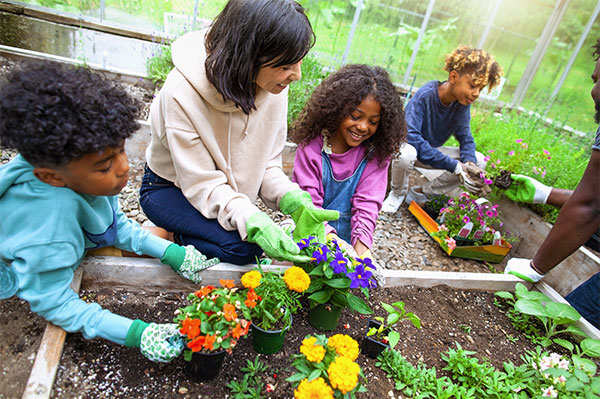Specialist Gardening Tips for Creating a Lasting and Eco-Friendly Garden
Embarking on the trip to produce a sustainable and green yard includes a series of calculated options and techniques that not just enhance the appeal of your area but additionally contribute favorably to the atmosphere. By selecting native plants that are well-suited to your area, you can decrease dependence on chemical fertilizers and pesticides while supplying vital support to neighborhood wildlife. Additionally, integrating water conservation methods and organic horticulture methods plays an essential duty in keeping a healthy and balanced ecosystem. To reveal more expert understandings and useful methods, allow us check out the essential elements that define an ecologically mindful yard.
Select Indigenous Plants
Selecting indigenous plants for your garden is an essential step toward achieving sustainability. In addition, indigenous plants commonly call for less water once established, contributing to more efficient water usage.
Beyond their useful benefits, indigenous plants play a crucial duty in supporting neighborhood biodiversity. They give necessary habitat and food sources for indigenous wildlife, including pollinators such as birds, butterflies, and bees. This promotes a well balanced ecosystem, which is essential for the health and wellness of your garden and the surrounding setting.

Implement Water Conservation
Executing water preservation strategies is important for preserving a lasting garden. Effective water use not just lowers the environmental effect however likewise makes certain that plants receive appropriate hydration without wastefulness. One effective method is to utilize drip irrigation systems, which provide water directly to the plant origins, lowering dissipation and drainage. This targeted technique can dramatically decrease water use contrasted to traditional sprinklers.
In enhancement, mulching is a beneficial technique for preserving water. By using a layer of organic mulch, such as timber chips or straw, around the base of plants, garden enthusiasts can minimize soil dissipation and keep constant moisture levels. Mulch likewise helps manage dirt temperature and suppresses weed development, more adding to plant health and wellness.
Rainwater harvesting is an additional lasting technique. Installing rainfall barrels or other collection systems allows garden enthusiasts to record and keep rainwater, which can later be made use of during completely dry periods. This not only conserves community water but additionally offers a natural, chemical-free resource for watering.
Last but not least, choosing drought-tolerant plant species can significantly reduce water demands. These plants are adapted to grow in low-water conditions, making them ideal for green yards. gardening tips. Executing these water conservation approaches will cultivate a durable, lasting garden
Usage Organic Gardening Methods

Pest monitoring in an organic garden depends on integrated pest management (IPM) techniques. These include encouraging useful bugs, utilizing all-natural predators like lacewings and ladybugs, and carrying out plant rotation to interrupt pest life cycles. Companion planting, where particular plants are expanded together to fend off pests or bring in helpful bugs, is another efficient technique.
Weed control is managed with mulching and manual removal, as opposed to depending on herbicides. Mulch not only subdues weeds yet likewise preserves dampness and boosts soil health as it damages down. Organic composts, such as Discover More Here straw, wood chips, and leaves, are particularly beneficial.
Develop Wildlife Environments
Developing wildlife habitats within your yard not only boosts biodiversity however also sustains the environment's balance. Deliberately spaces that attract and maintain local animals, you can produce a thriving micro-ecosystem that profits both pets and plants. Begin by integrating native plants, as these are fit to your regional climate and give crucial food and shelter for wild animals. Native vegetation supports a variety of bugs, birds, and tiny animals, adding to the environmental network.
Consider including a water attribute, such as a pond or birdbath, to supply a consistent water source. Water aspects attract a range of varieties, from amphibians to pollinators, boosting the garden's vitality. In addition, installing birdhouses, bat boxes, and insect hotels uses secure nesting websites and motivates biodiversity.
Leave some areas of your garden undisturbed, enabling ground cover and fallen link branches to collect. These all-natural particles piles create habitats for pests and tiny animals, fostering a balanced ecological community. Avoid using chemical pesticides and herbicides, as they can hurt valuable wild animals and interfere with food chains. By prioritizing these sustainable practices, your garden can end up being a shelter for neighborhood wild animals, advertising environmental health and wellness and sustainability.
Technique Composting and Mulching
A vital element of sustainable horticulture, composting and mulching, substantially improves dirt health and wellness and decreases waste. Unlike artificial fertilizers, garden compost enriches the dirt with crucial nutrients and helpful microorganisms, cultivating a healthier garden environment.
Mulching, on the other hand, includes covering the soil surface area with not natural or organic materials, such as straw, timber chips, or shredded fallen leaves. This practice supplies a number of benefits: it conserves dirt moisture, reduces weed development, and moderates soil temperature level. Mulch additionally gradually breaks down, including raw material to the dirt and further improving its fertility.
To practice efficient composting, guarantee your garden compost pile has a balance of environment-friendly products (rich in nitrogen) and brown materials (rich in carbon), maintaining ample aeration and wetness. gardening tips. Consistently turning the pile speeds see this here up decay. For mulching, use a 2-3 inch layer around plants, guaranteeing it does not straight contact stems or trunks to avoid rot
Conclusion

Selecting indigenous plants for your garden is an essential step towards achieving sustainability.Furthermore, incorporating native plants can improve the visual charm of your yard. These plants are adapted to grow in low-water problems, making them optimal for environmentally friendly gardens. Implementing these water conservation approaches will promote a resilient, sustainable yard.
In conclusion, developing a lasting and environmentally friendly garden includes the critical selection of indigenous plants, the fostering of water conservation methods, and the execution of natural gardening techniques.